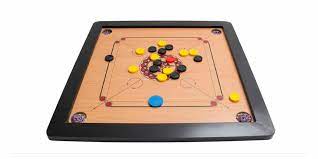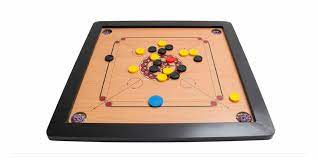Long popular in India and South East Asia, the carrom game has gained popularity in much of the rest of the world during the past century. Even though there is an international regulatory agency and several significant national bodies, there are a great number of changes in the laws depending on the circumstances. The rules below have been modified by Masters Games to be as straightforward as possible while still being based on those from the UK Carrom Club.
Objective
The carrom game has long been a favourite in South East Asia and India but has recently acquired appeal throughout most of the world. Even if there is a global regulatory body and several prominent national organizations, there are several legal variations depending on the situation. Masters Games have altered the following guidelines to be as simple as possible while still being based on the UK Carrom Club guidelines.
Basic rules
The player has three chances during the initial turn to “break,” or disrupt, the centre cluster of counters. It makes no difference whether piece the striker strikes first or if the striker makes no hits at all. The player returns the striker and takes another swing if the striker steals the Queen and one or more pieces of her colour. The turn is over if the player fails to collect any pieces or makes a foul.
How To Play Carrom Game
The carrom game, which requires “flicking” a “striker” to push the coins in the corner pockets, can be played by two, three, or four players.
The board game Carrom doesn’t need to be prepared. A carrom board can be set up in a 180-degree position on a carrom stand, the ground, a table, etc., so it is stationary and not subject to vibration or movement. Rub carrom powder (boric acid or potato starch) over your board before playing for a nice, quick game.
A Singles game can begin immediately with two players seated across from one another. In contrast, four players from two teams sit across from one another on the four sides of the carrom board when playing doubles.
Nine white counters, nine black counters, one red counter (the Queen), and a larger and heavier “striker” are the initial pieces or soldiers in the Carrom game. The carrom men should be flat with the Queen in the centre circle and the other carrom men arranged around her in the first row, keeping the white and black carrom men in alternate positions. Three white carrommen will alternately create the shape of a “Y” in the second row. Within the outer circle, all of the carrommen positioned as described above must be arranged in a tight circle contacting one another. Who will begin the game first is decided by the coin toss or spin?
Except for the red circle design at the end of the baseline, the carrom striker should be positioned contacting both lines of the baseline of the board parallel to the frame. It must be hit with the aid of a finger, with or without the support of other fingers, and is known as a stroke. The index finger, middle finger, or thumb must be used to flick the carrom striker. The carrom striker must not be pushed since pushing the hand is not permitted. The carrommen should be directed or led by the striker such that they drop or pocket in one of the four corners of the carrom board.
White carrommen must be pocketed by the opener, and black carrommen must be pocketed by the opponent before you. Pocketing of the Queen is only permitted if the player also pockets his carrommen during or immediately following the pocketing of the Queen. If a player bags a queen but fails to pocket his carrommen in the same or immediately the following stroke, the player will also miss his turn, and the Queen will be placed back in the center of the circle.
A player’s turn will continue as long as he or she pockets his carrommen and Queen in line with the rules; otherwise, it will transfer to the adversary. In doubles, the player sitting to the right of the player who had his turn receives the turn. If you miss or make a mistake, the game continues.
A striker or counter that bounces off the board, sinks another player’s counter or is pocketed can all result in penalties. If you incur a penalty, one of your previously pocketed men will be placed back on the board inside the center circle.
In the same manner that this game might end quickly, the person who finishes pocketing all his carrommen first wins the board. However, according to the legislation, a queen is worth 3 points, including 21 points, while a carrommen is worth 1 point. The opponent’s remaining carrommen will determine the points earned by the board winner on the board after the game is over.
Only if the player wins the board will he be entitled to get credit for the Queen’s worth. Even though he has pocketed and covered the Queen, the player who loses the board is not given credit for the Queen’s worth. Once he reaches 22 points, the player no longer has the benefit of receiving an extra 3 points for defending the Queen. A game must include either 25 points or eight boards. The game is won by the one who scores 25 points first or has the advantage at the end of the eighth board.
Conclusion
These are the fundamental rules for playing Carrom. The International Carrom Federation, which oversees this game in many nations, plans and manages the world championship competitions in Carrom. To ensure that the board game Carrom is played consistently on a global scale, they have developed Carrom Rules / Law Book. For a comprehensive list of rules governing how to play Carrom, please visit here: carrom rule book.
As you play the carrom board game more and more, you start to appreciate it more and more, and eventually, you master it. You can pocket carrommen nearly from any spot on the playing surface without allowing your opponents a second opportunity. This is known in the carrom game as “Break to Finish.” Try it out for yourself, and you’ll soon agree with us that Carrom is the finest indoor sports board game for the whole family.
Rohan Mathawan
This article is authored by Rohan Mathawan, who is presently working as the Vice President of Media Sales and Operations at Techstory Media. Rohan started his career as an online gaming and technology content writer and has written more than 5000+ articles for reputed brands and companies like Techstory Media, MarketingCrap, and a few other ad agencies in the last 4 years. Rohan loves to read about online gaming during his pastime. His passion to create content about online gaming force him to dive deep into the research of the topic and what comes out is a highly relevant and captivating piece of content that is appreciated by his readers.


